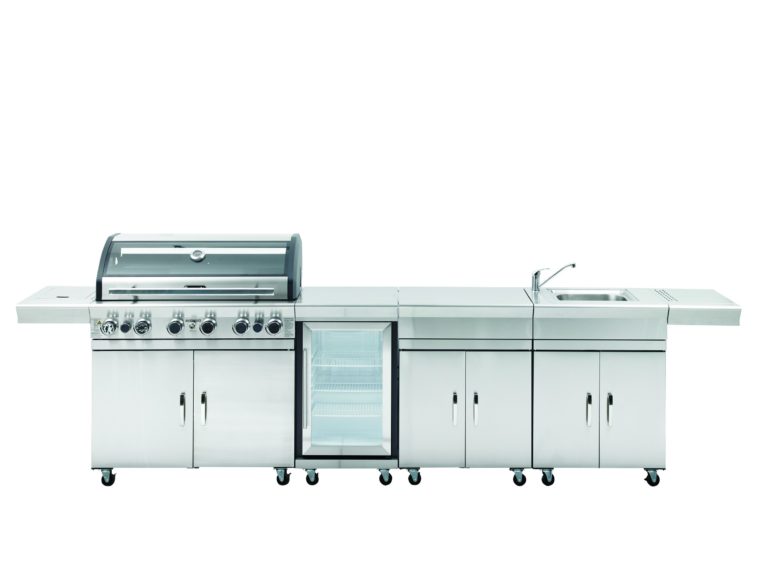Fire up the Holden for the sausages and chops
By John Cutt
PHOTOGRAPHS: Robyn Edie


A mobile barbecue built out of an abandoned Holden Statesman? Why not. This clever conversion by Scott Edwards, a former freezing-worker-turned-motor-mechanic, was the pin-up attraction at a car, bike, truck and boat Show Day held in Riverton, the popular coastal resort town about 32 km west of Invercargill.
Scott is currently completing an adult motor mechanic apprenticeship but has always had a flair for anything to do with engines. He began early. Scott’s partner, Nicola Swain, says his mother had told her that Scott pulled apart every toy he got as a child, then put them back together again to see how they worked before he played with them.
“He’s always tinkering with things,” Nicola says. That tinkering includes converting an old wheelchair into a bar stool, making a radio-controlled duck “that worked real good” and currently building a jet unit for a friend’s radio-controlled scaled-down jet boat.
He concedes that he has had a long-held interest in “anything with a motor.” Holden cars in particular are his passion including two Holden one-tonne utes and a Premier which he restored recently. He completely stripped it back to bare metal, repainting and building up a 350 Chev motor with a Weiand 671 supercharger. Scott is also the proud owner of a 1987 costumed Sportster 1200 cc Harley Davidson motorbike. At the Riviera Touring Club’s show last year, Scott’s Harley won runner-up best bike trophy.



Car barbecue
“The thought of turning a car into a mobile barbecue became a reality when a friend bought the rusting Statesman for a parts car and didn’t need the front end,” Scott says. “Making a ‘car’ barbecue was always one of those things I’d wanted to do. So I sat down one night and figured it out.”
The front of the car was unbolted. He sand-blasted the panels and replaced the rusted places with panel steel. Then he built a steel frame out of box section to replace the chassis, removed the axle and re-attached the wheels to a custom-built swing arm.
This made more room under the bonnet for storing the gas bottle, chilly bins and “other bits and pieces.” Scott says a bit of “bog” was skimmed over the panels before the barbecue was given a high-gloss black finish.


Hornet
The hotplate cover was carefully fine-cut from the bonnet panel, and on this, he mounted a fibreglass Hornet or air scoop. It’s held in place for travelling by four specially handmade V8 bolts. The cooking plate was made out of 10 mm mild steel, and a four-burner cooker was welded into place.
The unit has two doors that swing out to reveal fold-up, drop-down wooden shelves on the doors for cooking utensils and the cook’s “stubbie.” A trestle table bolts onto the towbar for travelling, and it doubles as a stone guard to protect the paintwork.
When the “car barbecue” is at rest and being readied for use, two installed Toyota Surf wind-up jacks come into play to level the barbecue vertically and horizontally, bringing it to the ideal cooking height.



Buckling
“A fair bit of thought went into it to make sure it worked alright,” Scott says. The only problem was when a test cook-up resulted in the plate buckling and some of the panels warping under the heat. Fortunately on cooling, the panels and plate straightened out. A series of venting holes drilled on either side of the plate solved the problem.
Scott says setting up the barbecue, which involves detaching the table and tow bar, removing the top panel, connecting the gas bottle and levelling, took about five minutes.
The impressive unit had its first official outing and test at the Riviera Touring Club’s annual community fund-raising show in Riverton in October and attracted many admirers. The club members on the barbecue and Scott were the subjects of numerous photo shoots. “Every time I looked up, someone was taking a photo,” Scott says.
Members of the club and Scott started the cook-up at 11.00 am, and by 1.00 pm, the venison steaks, sausages and patties from three deer had sold out. The sheer size of the plate ensured there were no worries keeping up with the demand.
The club’s car, bike, truck and boat shows raise funds for Riverton people with special needs.
Scott says the barbecue’s next big outing would be the Cromwell Car show in Central Otago in January.
Riverton is affectionately known as the Riviera of the South and has a reputation as the South’s artistic capital. but last year, in designing the logo for his local car club, Scott also showed he has an artistic side to his character. When the car club decided it needed a logo, Scott volunteered. The design chosen is impressive and shows Scott’s artistic/design flair. It features two pistons on either side of a green banner atop a pair of dice representing the “old school” look when dice were a popular accessory slung below the rear vision mirror in teenagers’ cars. The logo now appears on the club’s shirts, caps, badges and trophies.





